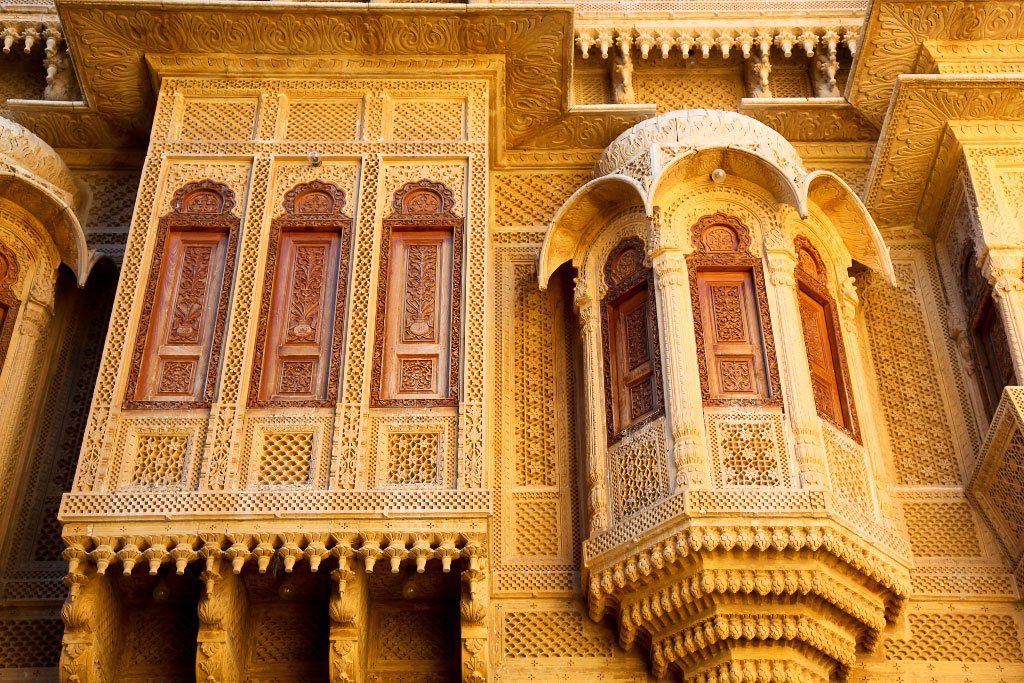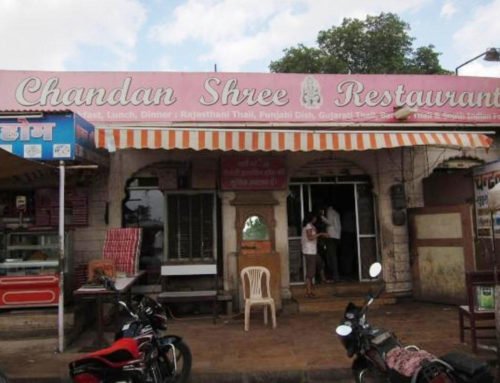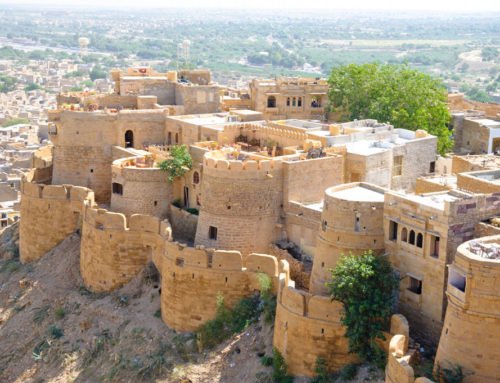Overview
- Features: Beautiful havelis (residences) made of intricately carved yellow sandstone
- Opening Times: Kothari’s Patwa-ki-Haveli 8:30 am to 7:00 pm; Nathmal-ki-Haveli 8:00 am to 7:00 pm; Salim Singh-ki-Haveli 8:00 am to 7:00 pm (May to Sep) & 8:00 am to 6:00 pm (Oct to Apr)
- Best Time to Visit: Late October to early March
- Duration: 30 minutes to 1 hour
- Travelled By: Foot
- Cost: Kothari’s Patwa-ki-Haveli Indian/foreigner Rs 50/120, camera Rs 40; Nathmal-ki-Haveli Rs 20; Salim Singh-ki-Haveli Rs 20, camera Rs 20
- Address: Jaisalmer, Rajasthan, India
- Type: Mansion
Author Reviews[display_rating_item_results rating_form_id=”2″ rating_entry_ids=”1″ show_category_filter=”false” show_options=”true” result_type=”star_rating” preserve_max_rating=”true” show_title=”false” show_count=”false” ]
Total Rating: [display_rating_result rating_form_id=”2″ show_count=”false” show_rich_snippets=true] [accordions load=”1″] [accordion title=”User Reviews” last] [display_rating_item_results rating_form_id=”5″ show_options=”true” result_type=”star_rating” preserve_max_rating=”true” show_title=”false” show_count=”true” show_rich_snippets=true] [/accordion] [accordion title=”Add Review”][display_rating_form show_email_input=”true” show_comment_textarea=”true” show_name_input=”true” rating_form_id=”5″] [/accordion] [/accordions]
Summary
Jaisalmer is well known for its beautiful havelis both inside the fort and in the walled area of the city. The most impressive and popular havelis are Patwa-ki-Haveli, Nathmal-ki-Haveli and Salim Singh-ki-Haveli. Made of yellow sandstone, a Jaisalmer haveli has intricately carved windows, balconies and doorways.
Jaisalmer Haveli
They have beautifully carved façades, jali screens and oriel windows overhanging the streets below. The ground floor is raised above the dusty streets and each has an inner courtyard surrounded by richly decorated apartments, carved stone archways and jharokhas (balconies).
The most popular Jaisalmer havelis are Patwa-ki-Haveli, Salim Singh-ki-Haveli and Nathmal-ki-Haveli.
Patwa-ki-Haveli
The most impressive and largest Jaisalmer haveli is Patwa-ki-Haveli which towers over a narrow lane in the north-east section of Jaisalmer. Theis haveli is one of the main tourist attractions in Jaisalmer.
It is divided into five sections and was built between 1800 and 1860. The first among these was commissioned and constructed in the year 1805 by Guman Chand Patwa, then a rich trader of jewellery and fine brocades, and is the biggest and the most ostentatious. Patwa was a rich man and a renowned trader of his time and thus ordered the construction of separate stories for each of his five sons.
The first of the five sections is opened as the privately-owned Kothari’s Patwa-ki-Haveli Museum which richly evokes 19th century life in India. It’s most impressive from the outside so we didn’t bother going inside.
[singlepic id=2705 w=720 h=560 float=center]
Possibly the finest in town, these havelis are made up of intricate stonework that looks like honey-coloured lace in the golden sun. These huge havelis built in yellow sandstone have beautiful murals and artistic carved pillars. A profusion of balconies cover the front wall and the inner courtyard is surrounded by richly decorated apartments; parts have been well restored. The main courtyard and some roofs are now used as shops.
[singlepic id=2701 w=720 h=560 float=center]
[singlepic id=2703 w=720 h=560 float=center]
These havelis are adorned with carvings on the doors, embedded ivory, golden paintings on the ceilings and walls, and Belgian glass in the lattices and balconies. Keeping in mind the climate of Jaisalmer, the floors are made of mud, and wood has been used for the roofs so that the havelis remain cool in summers and warm in winters. Each haveli has a diwan khana (audience hall), guest room, kitchen, basement, staircase, safes.
There are unofficial ‘guides’ lurking around in the lane way and will usually show you around for about Rs 20. We didn’t bother going inside as we thought it was more beautiful from the outside.
Nathmal-ki-Haveli
[singlepic id=2706 w=720 h=560 float=center]
Nathmal-ki Haveli, nearer Gandhi Chowk, was built in 1885 for the prime minister and is still partly inhabited. The left and right wings were the work of two brothers, whose competitive spirits apparently produced this virtuoso work – the two sides are similar, but not identical.
[singlepic id=2708 w=720 h=560 float=center]
[singlepic id=2699 w=720 h=560 float=center]
Partly carved out of rock by the two craftsmen, it has a highly decorative façade with an attractive front door guarded by two elephants.
It has an extraordinary exterior, dripping with carvings and the 1st floor has some beautiful paintings using 1.5 kg of gold. A doorway is surrounded by 19th century British postcards and there’s a picture of Queen Victoria. Inside is a wealth of decoration such as a tiny horse-drawn carriage and a locomotive showing European influence.
Salim Singh-ki-Haveli
[singlepic id=2711 w=720 h=560 float=center]
Near the fort entrance of Amar Sagar Pol, the 18th-century Salim Singh-ki Haveli has an amazing and distinctive shape. The top storey spreads out into a mass of carvings, with graceful arched balconies surmounted by pale blue cupolas.
Salim Singh was a notorious 19th century prime minister of Jaisalmer whose ill treatment of the area’s Paliwal Brahmin community led them to abandon their 84 villages and move elsewhere.
[singlepic id=2710 w=720 h=560 float=center]
It is especially attractive with peacock brackets; it is often referred to as the ‘Ship Palace’ because of its distinctive and decorative upper portion.
While these three havelis are the most spectacular and impressive havelis in Jaisalmer, this town is renowned for its havelis and it is possible to sleep in a beautiful Jaisalmer haveli anywhere in the city.






